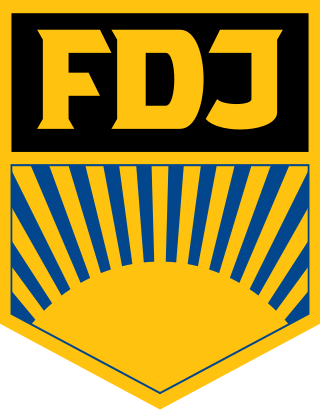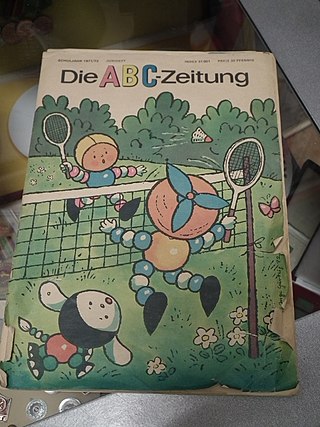Related Research Articles

The Free German Youth is a youth movement in Germany. Formerly, it was the official youth wing of the German Democratic Republic (GDR) and the Socialist Unity Party of Germany.

The Linksjugend ['solid](en: Left Youth ['solid]) is a political youth organisation in Germany. It is the official youth wing of the political party The Left. It was formed in 2007 as the legal successor to ['solid] – die sozialistische jugend which was the unofficial youth wing of the Left Party and its predecessor PDS. The name "solid" comes from sozialistisch, links, demokratisch(socialist, left, democratic.)

The Young Communist League of Germany was a political youth organization in Germany.
Junge Welt is a German daily newspaper, published in Berlin. The jW describes itself as a left-wing and Marxist newspaper. German authorities categorize it as a far-left medium hostile to the constitutional order.
German comics are comics written in the German language or by German-speaking creators, for the major comic markets in Germany, Austria, and Switzerland, with spill-overs into the neighboring, but lesser, comic markets of Liechtenstein, Luxembourg and German-speaking Belgium.
Neues Deutschland is a left-wing German daily newspaper, headquartered in Berlin.
FRÖSI was a children's magazine which was published by Junge Welt in the German Democratic Republic. The expanded title of the magazine was Fröhlich sein und Singen. It was the magazine for members of the Ernst Thälmann Pioneer Organisation. The word FRÖSI comes from the first line of the at that time familiar pioneer song "Fröhlich sein und singen". This title in full length was used until 1965, then the short form replaced it. The first edition was released on 25 June 1953. At first it was published every 6 weeks, from 1956 monthly.

Paul Verner was a German communist politician. He joined the communist movement at a young age and went into exile during Adolf Hitler's rule. Verner became a prominent political personality in the German Democratic Republic after the war.
Zentralorgan is a 19th-century German term for journals associated with a certain technical field, party or political movement. Later it was reduced to a term for official party papers and journals of socialist and worker parties since the 19th century.

Herbert Schoen was a German international footballer.

ABC-Zeitung was a German monthly children's magazine published between 1946 and 1996.

Stasi Decorations and Memorabilia, by Ralph Pickard is a three-volume, in-depth analysis of the socialist political culture of the Ministry for State Security (Stasi) of the German Democratic Republic (GDR). It provides information about the organization using artifacts such as medals, certificates, and other objects to document the Stasi's awards and recognition of its members. Altogether, all three volumes contain over 900 pages with over 1700 illustrations.
The Lied von der blauen Fahne was an East German patriotic song written by Johannes R. Becher and set to music by Hanns Eisler. Both Becher and Eisler were also the creators of Auferstanden aus Ruinen, which became the national anthem of the German Democratic Republic (GDR).

Manfred Feist was a German politician and party functionary. He served as Director of the Foreign Information Department of the Central Committee of the ruling SED (party).

Edith Baumann was a German politician. She was a co-founder and official of the Free German Youth, the youth organisation that after 1946 became the youth wing of East Germany's ruling Socialist Unity Party . Between 1946 and her death she was a member of the country's powerful Party Central Committee.
Marlies Deneke is a German politician.

Horst Pehnert was an East German journalist and party official who in 1976 became a long-standing deputy Minister for Culture - effectively the minister for film and cinema.
Brigitte Zimmermann is a German journalist. Between 1983 and 1991 she was editor in chief of Wochenpost, East Germany's top selling weekly newspaper.
Melodie und Rhythmus was a German countercultural magazine founded in East Berlin in November 1957 as a music magazine. The magazine initially focused on dance and easy listening music in the German Democratic Republic, and slowly expanded its content to pop and rock until its discontinuance in 1991. Between 2004 and 2022, Melodie und Rhythmus adopted a similar approach but it gradually shifted towards socio-political issues.

Jugend und Technik, also stylized as Jugend + Technik, was an East German popular science and technology magazine targeting youth. Its subtitle was das faszinierende Technikmagazin. The magazine appeared between 1953 and 1991 and was headquartered in East Berlin.
References
- ↑ John D. Benjamin (2019). "Relocating the Text: Mosaik and the Invention of a German East German Comics Tradition". The German Quarterly . 92 (2): 149. doi:10.1111/gequ.12100.
- 1 2 3 4 5 6 Michael F. Scholz (2020). "Images of Spies and Counterspies in East German Comics". In Martha Kuhlman; José Alaniz (eds.). Comics of the New Europe: Reflections and Intersections. Leuven: Leuven University Press. pp. 160, 164. doi:10.2307/jj.2487428.14. ISBN 9789461665270.
- 1 2 3 Sean Eedy (2018). "Four colour anti-fascism: postwar narratives and the obfuscation of the Holocaust in East German comics". Journal of Modern Jewish Studies. 17 (1): 25–26. doi:10.1080/14725886.2017.1382071. S2CID 148646502.
- 1 2 3 4 "Atze". ddr-werbefiguren-welt.de (in German). Retrieved 3 August 2023.
- 1 2 3 4 5 6 7 "Atze". ddr-comics.de (in German). Retrieved 3 August 2023.
- ↑ "Fix-und-Fax-Schöpfer Jürgen Kieser ist tot". ntv (in German). 21 May 2019. Retrieved 3 August 2023.
- ↑ Sean Eedy (2014). "Reimagining GDR comics: Kultur, children's literature and the socialist personality". Journal of Graphic Novels and Comics. 5 (3): 246. doi:10.1080/21504857.2014.908402. S2CID 154817600.
- ↑ "Atze-Datenbank". weisshahn.de (in German). Retrieved 3 August 2023.